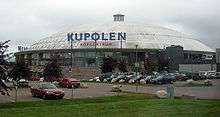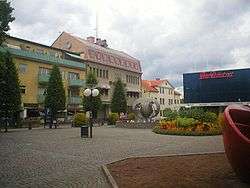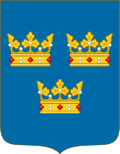Borlänge
| Borlänge | |
|---|---|
|
Sveatorget in Borlänge | |
 Borlänge  Borlänge | |
| Coordinates: 60°29′08″N 15°26′11″E / 60.48556°N 15.43639°ECoordinates: 60°29′08″N 15°26′11″E / 60.48556°N 15.43639°E | |
| Country | Sweden |
| Province | Dalarna |
| County | Dalarna County |
| Municipality | Borlänge Municipality |
| Founded | 1944 |
| Area[1] | |
| • Total | 34.36 km2 (13.27 sq mi) |
| Elevation | 151 m (495 ft) |
| Population (31 December 2010)[1] | |
| • Total | 41,734 |
| • Density | 1,200/km2 (3,100/sq mi) |
| Time zone | CET (UTC+1) |
| • Summer (DST) | CEST (UTC+2) |
| Postal code | 781 xx |
| Area code(s) | (+46) 24 |
| Climate | Dfb |
| Website | Official website |
Borlänge [²boːɭɛŋːɛ] is a locality and the seat of Borlänge Municipality in Dalarna County, Sweden, with 41,734 inhabitants in 2010.[1]
History
.jpg)
Originally Borlänge was the name of a tiny village, and the first historical information about it is from 1390. The village was insignificant up until about 1870. In 1875 a railway between Falun and Ludvika, via Borlänge was inaugurated and at the same time the construction of Domnarfvets Jernverk, the ironworks of neighbouring village Domnarvet, had started. Thanks to its railway station the village of Borlänge became highly important in servicing the ironworks.
In 1898, Borlänge was granted privileges by the national Swedish government as a town of its own (Swedish: köping) with about 1,300 inhabitants, but still today it belongs to the Church of Sweden's regionally historically dominant parish of Stora Tuna, centered on a large medieval cathedral by that name (meaning great enclosed farmyards), now located in a rural district east of the city.[2] In the 1900s, the Stora Kopparbergs Bergslag - the owner of the ironworks in Domnarvet at the time - built a papermill in an adjacent village to Borlänge called Kvarnsveden. Many area residents emigrated to the United States in the late 19th and early 20th centuries.
In 1944, the City of Borlänge was incorporated after the market town joined the industrial towns of Domnarvet and Kvarnsveden. In 1971 the municipality of Borlänge was established when the Stora Tuna municipality merged with the City of Borlänge.
During all of the 20th century Borlänge has been a typical heavy industry community with relatively good economic growth; today the service industry is also thriving and in considerable expansion.
Industry
Borlänge has always been an industrial town surrounding the iron mill of Domnarvet (SSAB) and the paper mill of Kvarnsveden (Stora Enso). As a city with a structure heavily divided by rails and roads, with a modern city center, Borlänge also houses the head office for a state authority - the National Swedish Transport Administration Trafikverket.
Shopping

Borlänge promotes itself as The Number One Shopping City in Dalarna. This is possible due to the Kupolen area, situated about 1 kilometer west of the city centre. The Kupolen area includes Kupolen ('The Dome') Shopping Centre and the surrounding region. Though the district was first built to catch the interest from bypassers it has withdrawn the focus from the nearby downtown.
In the city centre you will find about 80 shops and 40 restaurants and cafés. Some with a long history; such as Qwarnströms, Almas Café, Tyllströms and Lindés Ur och Guld, but also newer ones with a strong personality like Selected Style, Brädgårn, Sara 1896 and Önskehuset.
Sport
The city boasts a soccer team that has been successful in the past, although it is currently going through some hard times. IK Brage, named after the Norse god, has a history of 18 seasons in the Swedish Premier Division (Allsvenskan). Brage plays in green and white and hosts its home games at Domnarvsvallen Stadium in Borlänge, with a seating capacity of 6,500. Another Borlänge team which has had a great deal of success in the sport, with both domestic and foreign fans following their progress, is the multicultural soccer team Dalkurd FF.
Other sports clubs located in Borlänge include:
In 2013, a Somali national bandy team was formed in Borlänge with the goal of participating in the 2014 Bandy World Championship.[3]
The 2008 Women's Bandy World Championship was also arranged with Borlänge as the main venue.
The 1993 World Gliding Championships were held at the Borlänge Airport, east of the town.
Music
Music is an important part of Borlänge. It has been the hometown of many new young musicians in Sweden such as Mando Diao, Sugarplum Fairy and Miss Li and offers the possibility to get a degree in popular music at BoomTown Music Education, a branch of the School of Music at Luleå University of Technology. The Stoner Rockband STONEWALL NOISE ORCHESTRA (Short S*N*O) was formed 2004 in Borlänge.
Located in Borlänge for many years except for 2013, is the annual Peace & Love music festival.
Notable people
- Klara Myren, hockey player
- Simon Aspelin, tennis player
- Astral Doors, heavy metal band
- Jens Bergenström hockey player
- Jussi Björling, tenor
- Cryonic Temple, metal band
- Dozer, stoner rock band
- Erik Eriksson, Centre Party's first chairman
- Tomas Forslund, ice hockey player
- Per Fosshaug, bandy player
- Lars Frölander, swimmer
- Greenleaf, stoner rock band
- Lars Jonsson, ice hockey player
- Gabriel Karlsson hockey player
- Mando Diao, rock band
- Miss Li, musician
- Lasse Nilsson, football player
- Mattias Ritola hockey player
- Rootvälta, reggae band
- Sator, rock band (earlier Sator Codex)
- Sugarplum Fairy, rock band
- Johan Olof Wallin, archbishop, poet and psalmist
Education
References
| Wikimedia Commons has media related to Borlänge. |
- 1 2 3 "Tätorternas landareal, folkmängd och invånare per km2 2005 och 2010" (in Swedish). Statistics Sweden. 14 December 2011. Archived from the original on 10 January 2012. Retrieved 10 January 2012.
- ↑ Find-a-Grave article
- ↑ "Swede to coach first Somalia bandy team". Radio Sweden. 13 May 2013. Retrieved 22 June 2013.

